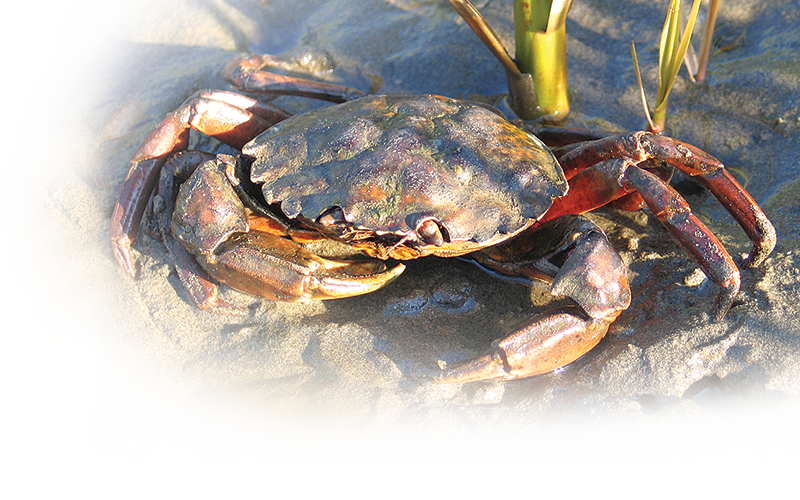Green Crabs Have Arrived in Puget Sound: Are They Here to Stay?
Washington Sea Grant’s monitoring program works to prevent invasive green crabs from establishing populations in Puget Sound
By Jasmine Prat, WSG Science Communications Fellow
Puget Sound shorelines are teeming with life, from birds soaring overhead, to schools of salmon smolts darting through the shallows, to crabs scuttling along the beach. But what if one species could shift the balance of this entire coastal ecosystem?
The Washington Sea Grant Crab Team thinks the invasive European green crab has the potential to do just this. Green crab is considered one of the world’s 100 most invasive species and has proven to be highly mobile and incredibly adaptable, as well as an aggressive predator. For decades, researchers have watched green crabs disperse around the world, damaging coastal habitats in the process. In 2016, the first green crab was documented on Washington’s inland shorelines. If their numbers increase and spread, instead of the wealth of diversity we see today, beaches could contain mounds of green crabs, which have the capacity to outcompete several local species for food and shelter. With a meticulous monitoring program, Crab Team works to stop the green crab invasion before these detrimental impacts take place on Washington’s shores.
Currently, Crab Team works with over 250 volunteers, tribal biologists and state agency personnel to monitor for green crab at 54 sites in Washington. In 2018, Crab Team volunteers alone spent over 4,000 hours conducting monthly surveys from April through September, when the crabs are most active. To date, there have been almost 200 crabs found across seven monitoring sites in Puget Sound. Most of these crabs were found at Dungeness Spit, near Sequim.
The threat of green crabs establishing in Puget Sound and their potential effect on native species has not been taken lightly. “The biggest risk we face from the green crab is the fact that it prefers to be a predator,” says Emily Grason, program manager of Crab Team. “It can survive and thrive eating almost anything, and because of its tendency to become extremely abundant, just through eating things it can have really dramatic impacts on the native habitats that it invades.” A green crab’s diet can include many species cultivated by the shellfish industry, including clams, oysters and mussels. Green crabs can also devour the eelgrass used as nursery grounds for Dungeness crab and salmon, and in other regions they have turned formerly lush habitats into stretches of mudflats.
Researchers have long feared the spread of green crabs into inland Washington. Green crabs are highly mobile, traveling on ocean currents for months at a time in their larval stage, and they are adept at hitching a ride in shipments of shellfish or on marine gear as adults. They first appeared on the West Coast in San Francisco Bay in the late 1980s, and spread in fits and spurts over the following two decades. Green crabs were discovered on Washington’s outer coast in 1998, where they remained largely contained for nearly two decades. However, in 2012 green crabs were documented on the Canadian side of the inland sea shared by British Columbia and Washington. Called the Salish Sea, this body of water includes Puget Sound, the Strait of Juan de Fuca and the Strait of Georgia.
In response, Washington Sea Grant and Washington Department of Fish and Wildlife formed Crab Team, which began preemptive monitoring for green crabs in 2015.
Over the first year of monitoring, no green crabs were found. However, in August of 2016, one was hauled in from a muddy crab trap in Westcott Bay on San Juan Island. “On the one hand, I was really disappointed that the green crab was captured,” says Jeff Adams, project lead of Crab Team. “While on the other, I was very happy for the validation of the Crab Team approach and that early detection now gave us a chance to control any concentrations of green crabs.” To carry out their monitoring efforts, Crab Team recruits volunteers to set up crab traps at sites around Washington where green crabs are most likely to establish. Volunteers record numbers, sex ratios and sizes of all trapped organisms, providing important baseline information about our local crab and other native species populations, as well as green crab detections.
Increasing temperatures create cause for worry about invasion rates increasing. “During warm winters, survival tends to be better for green crab, so not only do they spread more, we expect their survival to be higher,” explains Sean McDonald, Crab Team’s co-principal investigator. This past winter started out unusually warm and, by late January, shellfish growers had already reported three green crabs in Samish Bay—the first time green crabs have been sighted in Washington during the winter months. This is especially concerning because one of the crabs was a female with eggs, which was the first evidence of reproduction within the Washington waters of the Salish Sea.
However, the fact that these observations are being made is a testament to the effectiveness of Crab Team education and outreach to diverse partners, and Crab Team remains hopeful that further spread of the crab is still preventable. “Across all these sites, we’re really not talking about a lot of crabs . . . yet,” says Grason. “We’re finding them pop up as one or two or three individuals and we’re looking really hard to find them, which gives us some indication that they’re still really, really rare.”
Crab Team wants to keep it that way. The team hopes their work and local news of green crab migrations will attract additional public awareness and involvement, as well as continued program resources. Crab Team continues to seek new volunteers to join their monitoring efforts and encourages members of the public to report any green crab sightings. They need as many eyes on the beach and boots in the mud as they can get!
